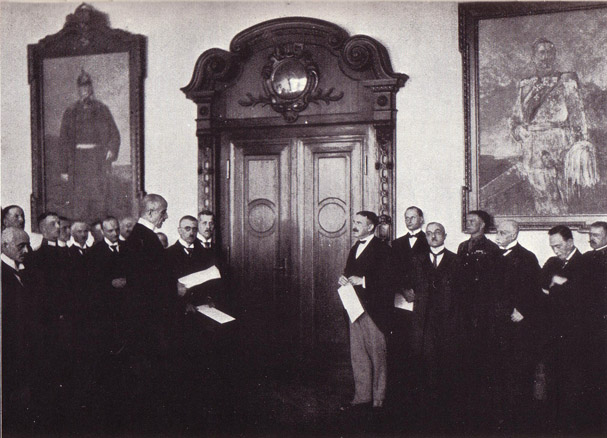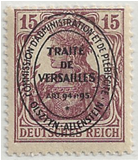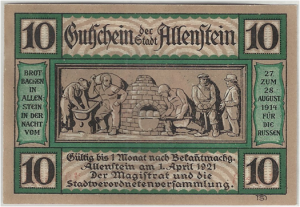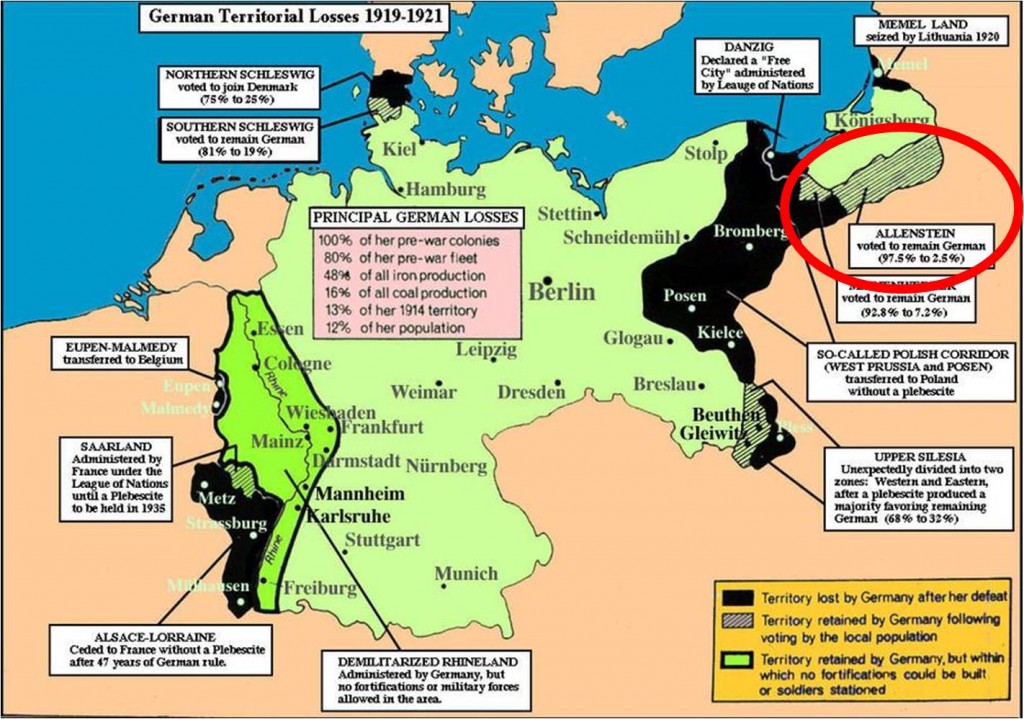ALBUM – view my Allenstein Album
Summary
Allenstein was an independent city within the German Empire. After the defeat of Germany in WW1, the Treaty of Versailles called for Allenstein to conduct a plebiscite (election) to determine their national alignment. The vote was held on July 11, 1920, with almost 98% voting to remain with Germany. The formal handover from the Commission to German authorities occurred on August 16, 1920.
Fast Facts
Region: Germany / Poland Area
Group: Occupations and Plebiscites post wwI
Classification: Plebiscite
Prior Regime: The German Empire
Key Dates:
1919, Jun – Treaty of Versailles
1920, Feb 12 – British and Italian troops arrive
1920, Jul 11 – Plebiscite
1920, Aug 16 – Handover to Republic of Germany
First Stamp Issued: April 3, 1920
Following Regime: Germany, Weimer Republic
Scott Catalogue: (Allenstein) #1-28
Pick Catalogue: none
Brief History of Allenstein

As the Allies decided to establish Poland as an independent state, a large part of West Prussia was awarded to Poland (along with its large German population) to give the new nation access to the Baltic Sea. While this access to a seaport was considered necessary for the survival of the country, it created a strip of land, often called the Polish Corridor, that essentially split East Prussia off from the rest of Germany.
Allenstein (Olsztyn, in Polish) was a district in East Prussia from 1818 – 1910, when it became an independent city within the German Empire. According to the Treaty of Versailles, Allenstein was placed under the authority of the Inter-Allied Commission, and British and Italian troops began arriving on 12 February, 1920 to oversee the plebiscite. While the German Army had already left the area, civil and municipal administration continued under existing German authorities who were accountable to the Commissions. On 11 July, 1920, the vote was held and almost 98% of the voting population chose to remain with East Prussia in Germany. The formal handover from the Commission to German authorities occurred on 16 August, 1920 and Allenstein, along with Marienwerder became part of East Prussia.
Allenstein remained under the control of Germany until the end of World War 2, when it became a part of an expanded Poland
Stamps
 ALBUM
ALBUM
During the lead up to the plebiscite, postage stamps of Germany were overprinted and issued to help publicize the event. Two different overprint designs were produced. The first design consisted of three lines reading: “PLÉBISCITE / OLSZTYN / ALLENSTEIN”, and was overprinted in 14 different denominations ranging from 3 pfennig to 3 marks.
The second overprint design consisted of an oval with the words: ”TRAITÉ DE VERSAILLES / ART. 94 et 95”, printed in in the center, and the full name of the plebiscite commission printed within the outside border.
Allenstein stamps were first issued on 3 April, 1920, and were valid until 20 August.
Banknotes
 No Allenstein specific banknotes were issued during the plebiscite era. However, a great period of inflation broke out in Germany after the war, causing great strains on the economy. In the early 1920’s, Notegeld (emergency money) was issued in many local regions, Allenstein included. The notes were meant to used for local bartering as the German Mark plummeted and metal was in short supply. The bright colored notes featuring local buildings or folklore created a strong demand from collectors. Quite often these sets, known as “Serienscheine” (serial paper money), were never actually produced for circulation, but instead sold to dealers.
No Allenstein specific banknotes were issued during the plebiscite era. However, a great period of inflation broke out in Germany after the war, causing great strains on the economy. In the early 1920’s, Notegeld (emergency money) was issued in many local regions, Allenstein included. The notes were meant to used for local bartering as the German Mark plummeted and metal was in short supply. The bright colored notes featuring local buildings or folklore created a strong demand from collectors. Quite often these sets, known as “Serienscheine” (serial paper money), were never actually produced for circulation, but instead sold to dealers.
Links
East Prussian Plebiscite at Wikipedia
Plebiscite issues make interesting collection from Linns
Allenstein Plebiscite from Stamp Collecting World
Allenstein at BigBlue 1840-1949 by Jim Jackson
Stamps of Distinction – Allenstein






The Polish Corridor dates from the middle ages. Duke Conrad of Masovia had problems with the pagan Old Prussians, who were related to the Lithuanians. Unable to get help in Poland, he asked for it in Germany. The German Order (Teutonic Knights) and others answered, and conquered the Prussians. The Teutonic Knights and friends then expanded into Latvia and Estonia, and finally into Lithuania. In 1410, the Poles, Lithuanians and others won the Battle of Tannenberg over the Teutonics, and recovered Lithuania. In spite of some German incursions, the Polish Corridor remained until the First Partition of Poland in 1772. In 1919, it still had a substantial Polish majority. Some areas that had been Polish before 1772 stayed with Germany because of German majorities. The Allenstein plebiscite was marked by fraud and coercion.
Hi David
Welcome to DCStamps, and it is great to see people who are very interested in history. This whole area of the world is fascinating, and we just visited Lithuania, Latvia and Estonia last year and saw several of the historical sites.
Regarding Allenstein, most of the plebiscites after WW1 had their issues, especially as the populations of the regions were quite mixed. However, regardless of the chaos, those areas with a high German/Prussian population needed to have a say in their alignment.
Michael
Where can one get a decent map of Allenstein showing the districts and towns of the 1920s?
Hi David
First of all, try searching “Olsztyn”, which is Polish for Allenstein.
Here are a couple of links for maps which might get you started –
http://www.mapywig.org/m/wig750k/WIG_750K_D0_KROLEWIEC,OLSZTYN,BIALYSTOK,SUWALKI_1925_200dpi.jpg
and
http://upload.wikimedia.org/wikipedia/commons/5/54/Poland_%26_The_New_Baltic_States.jpg
Happy Hunting
Michael
Met you yesterday at the Fort Washington Stamp Show. Terrific Web Site. Great historical info and pictures. Keep up the great work you’re doing.
Orlando
Nice to meet you as well. Thanks for the comments, and I hope to to see you at an upcoming stamp show. Would love to learn more about your collection.
Michael